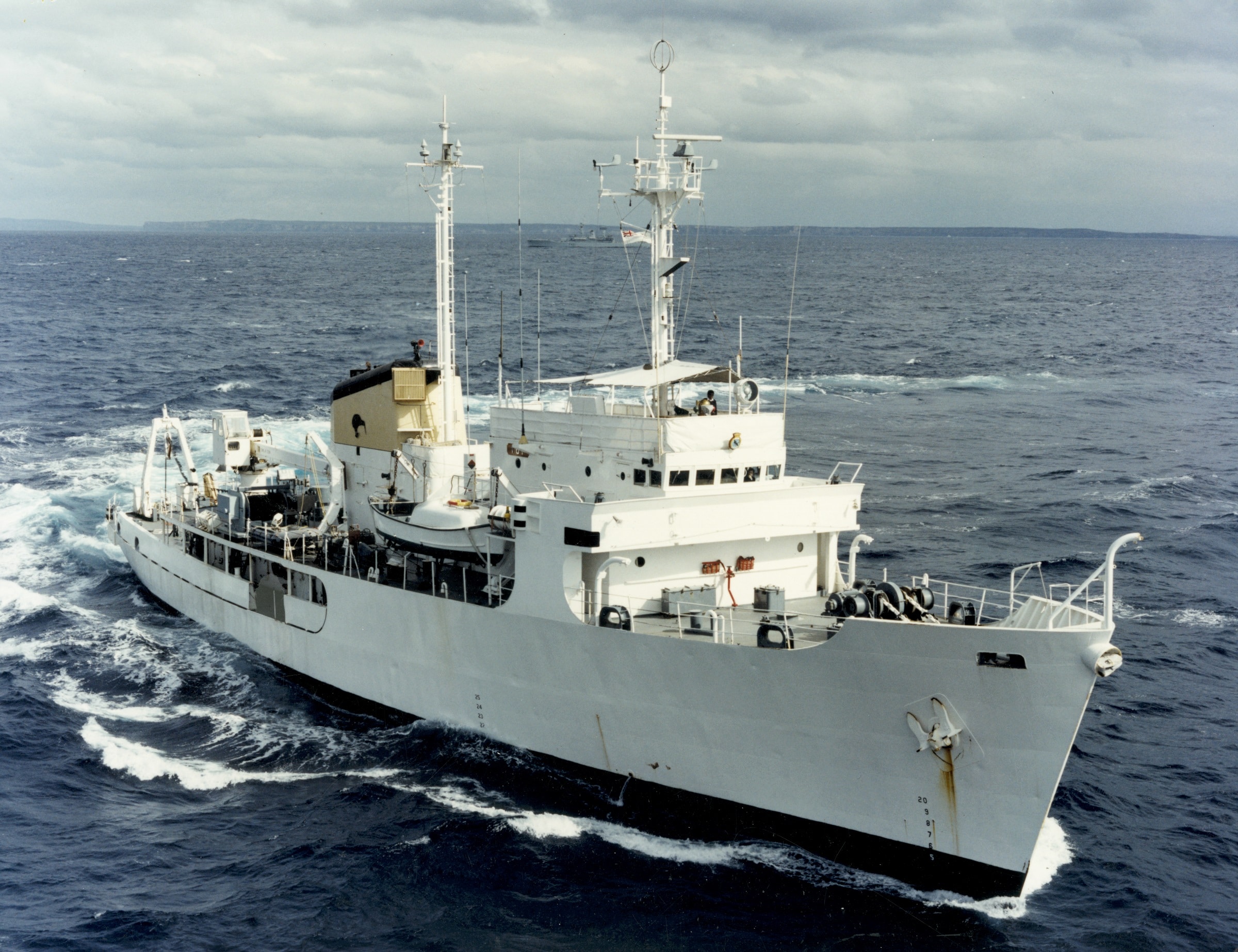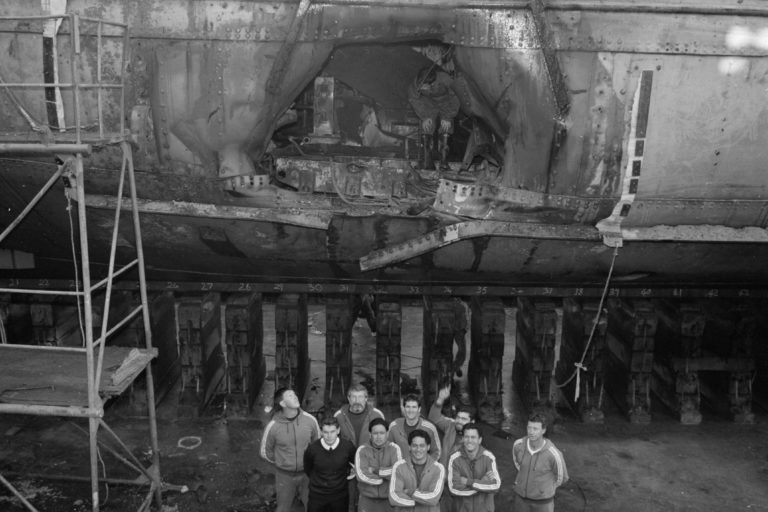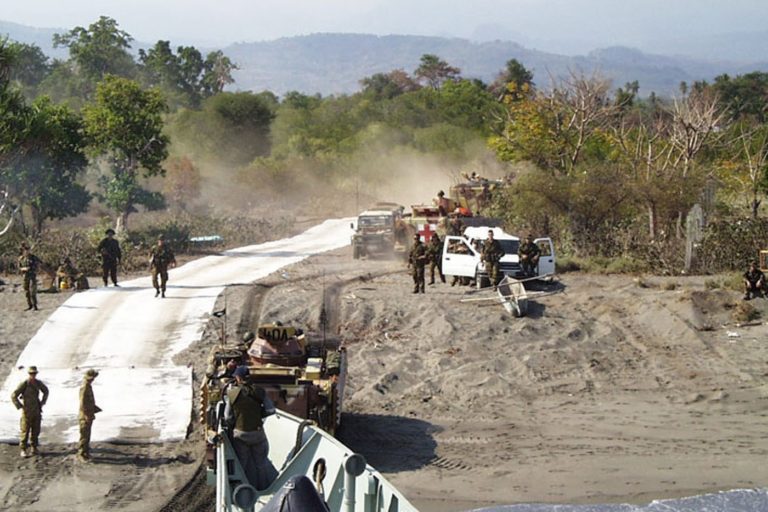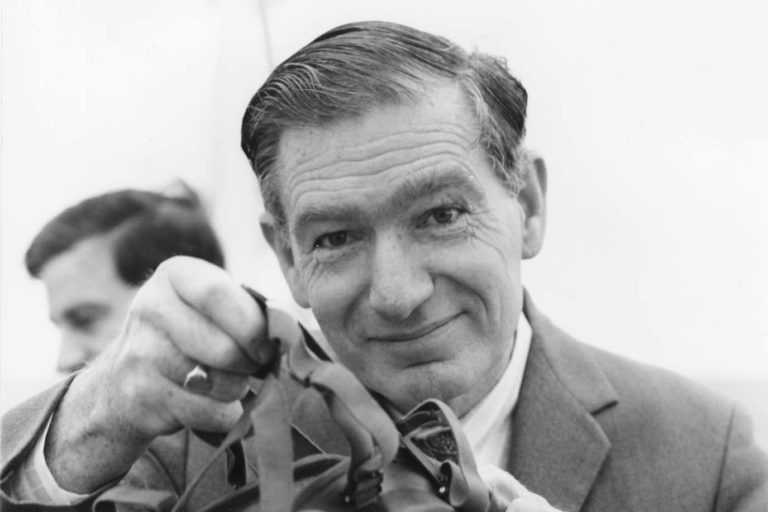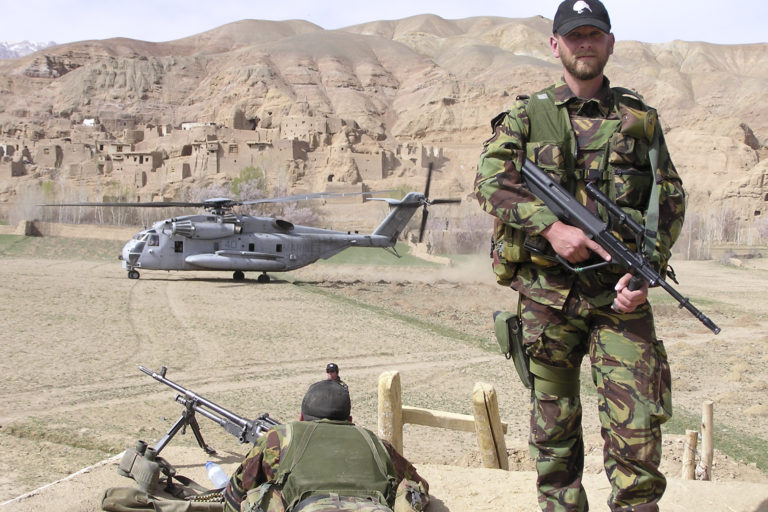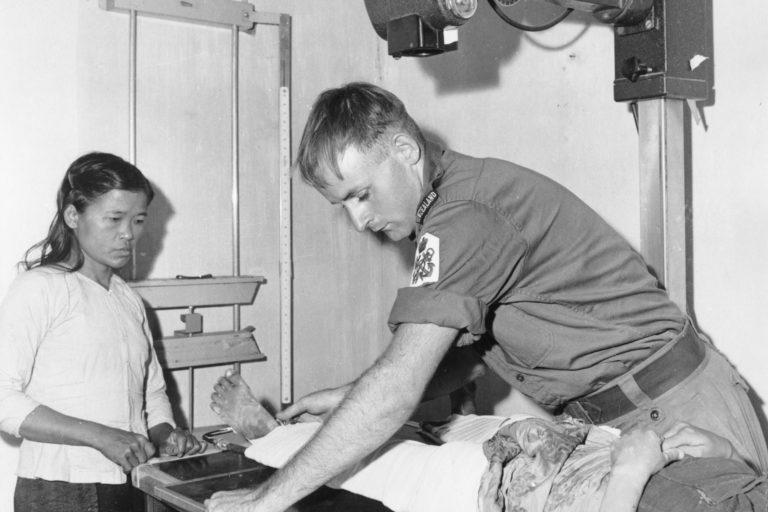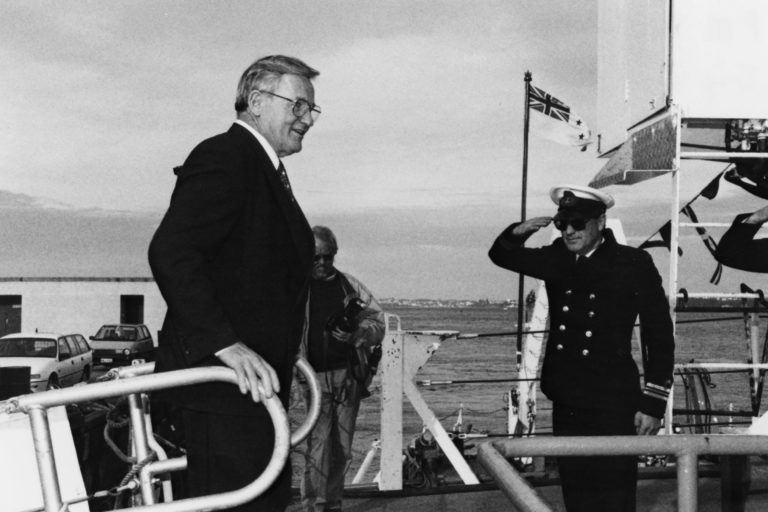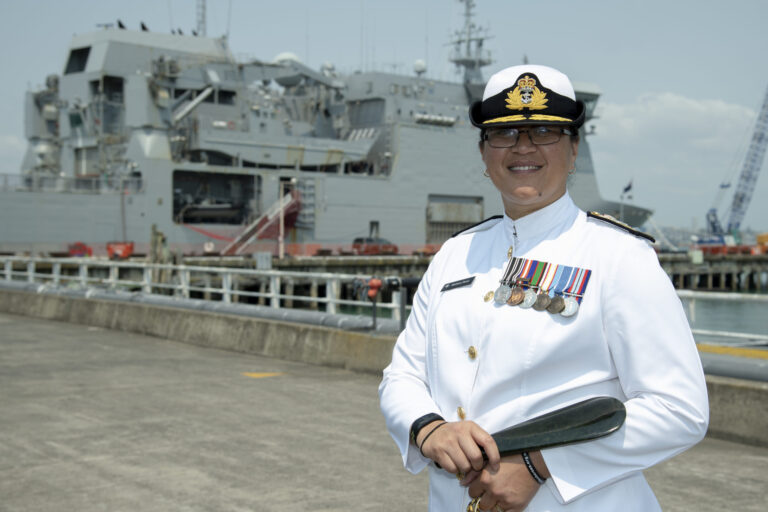Tui was formally commissioned for RNZN service on 11 September 1970, at the Brooklyn Navy Yard, New York. While the prime user of the ship was the Defence Scientific Establishment, the ship frequently worked for other institutions, such as the Universities of Auckland and Hawaii and the Department of Scientific and Industrial Research.
Ship details
Type: Oceanographic vessel ex USNS Charles H. Davis
Dimensions: 63.4m x 11.3m x 6m
Machinery: 2 x Caterpillar diesels, single shaft = 12 knots
Armament: Not armed
Commissioned: 10 September 1970
Paid off: 18 February 1998
Complement: 3 Officers, 33 ratings plus up to 10 scientists
Ship’s Badge
This badge was originally suggested by the Navy Office for use by the Bird-class corvette that was to enter service in 1942, but it was never actioned. The badge was formally approved in 1953 and featured the reverse of the penny piece. When the badge was issued in 1970, the kowhai leaves and flowers were removed.
Ship History
HMNZS Tui was built by Christy Corporation at Sturgeon Bay, Wisconsin. The ship was taken into the United States Naval Service (USNS) as USNS Charles H. Davis [AGOR-5] in January 1963. It was one of the Conrad class of seven oceanographic research ships utilised on a ‘pool basis’. Charles H. Davis had been in reserve for some years before being leased to the Royal New Zealand Navy for five years from 28 July 1970. Her predecessor was scrapped in Auckland in 1970. The lease was renewed for a further five years to 1980 and again in 1979 for a further 15 years. The ship was eventually purchased for the RNZN by the government.
Tui was formally commissioned for RNZN service on 11 September 1970, at the Brooklyn Navy Yard, New York. After sea trials, the ship sailed for New Zealand on 24 September via Panama and Tahiti. On arrival in Auckland on 13 November 1970 Tui underwent a refit to install the specialist scientific equipment required for its New Zealand research programme. Tui was adopted by the city of Napier and granted the Freedom of the City.
The prime user of the ship was the Defence Scientific Establishment. However, the ship frequently worked for other institutions, such as the Universities of Auckland and Hawaii and the Department of Scientific and Industrial Research. Although Tui was primarily equipped for underwater acoustic research, its tasks undertaken were many and varied. These included water sampling, mapping underwater volcanoes, testing parachutes for use as sea anchors, servicing lighthouses, acoustic experiments, servicing the RNZN Sound and Degaussing Ranges and developing anti-submarine towed arrays. In the late 1970s, Tui took part in joint research with the Royal Australian Navy vessels HMAS Diamantina and Kimbla. She also worked with the United States Navy up to 1985.
From a personal aspect, Tui was not a comfortable ship to live in. The ship’s stability and resultant motion gave frequent concern. Another notable point was the ship’s very long range, in excess of 15,000 nautical miles (27,780 km). This meant that it only had to refuel about once a year. Such a range resulted in the little-known fact that Tui had the largest fridges of any ship in the navy and could stay at sea for long periods. Nevertheless, it was a popular posting.
Tui’s last major deployment was in 1995 as part of Operation Valerian. In May 1995, Jacques Chirac, running for French President, promised that if elected he would end the moratorium on the testing of nuclear devices. He won the election and announced on 13 June that between September 1995 and May 1996 there would be a new series of eight tests at Mururoa Atoll.[1] France was pursuing its status as a world power and wanted to retain the option of having an independent nuclear deterrent. The last of the underground tests had been conducted in 1991 and the moratorium instituted on 8 April 1992.[2]
One reason given for the resumption of testing was to verify the safety and reliability of the devices. Another reason was the intent to develop warheads with better yield-to-weight ratios.[3]
France indicated that it would be willing at the end of the testing programme to be a party to the Comprehensive Test Ban Treaty.[4] New Zealand protested and sought, as they had in 1973, a legal avenue to prevent the tests by using the International Court of Justice. The claim for an interim injunction against further French testing was filed on 21 August 1995, but the hearing would not start until 30 October, well after the first tests had been conducted.[5] It was clear that the level of public resentment and outrage against the French nuclear testing programmes surprised both Australia and New Zealand.[6] The United States offered to share computer modelling data from nuclear tests with France, something that was unthinkable in 1973.
Despite the public outcry, Australia would not deploy a naval vessel, arguing that a naval vessel should be used for naval purposes only, i.e., naval warfare.[7] The New Zealand Government took a different view. In part due to the political and public pressure, the government announced that a ship would be sent but to operate outside the 12-mile (19-km) territorial limit. Part of its intended role would be to offer support to the flotilla of protest vessels.[8]
On 18 July 1995, Prime Minister Jim Bolger announced that there was broad agreement to send a Royal New Zealand Navy ship to support the protest fleet. HMNZS Tui was identified as the ship to be sent to Mururoa and it was also agreed that MPs would voyage to the testing zone.[9] The RNZN would be sending an unarmed oceanographic research ship and not a warship, a gesture intended not to antagonise the French further.
On 24 July 1995, a warning order was issued to the commanding officer of Tui ‘for a 70-day deployment to the South Pacific in support of Government initiatives at Mururoa.’[10] Two days later the government stated that it hoped that there would be a reduction in the number of tests but felt it was a ‘very slim hope’.[11] During this period a lot of equipment was removed off Tui in preparation for the deployment, including making room for civilian passengers.[12]
On 4 August, Tui was ready for Operation Valerian. This was the name given to the operational deployment of Tui to Mururoa.[13] At the time of the decision to send a vessel, it had been intended to put Tui into operational standby so the change of plan impacted on the navy’s budgets for that year.
Members of Parliament Chris Carter and Brian Neeson boarded the vessel for the first phase of the deployment.[14] After a photo opportunity with Prime Minister Jim Bolger, officers from the RNZN, including the commanding officer of Tui, Lieutenant J. F. Campbell, briefed the Peace Flotilla on her role upon arriving at Mururoa. The skippers of the protest fleet ‘were surprised that Tui would not be escorting or herding the flotilla to Mururoa.’[15] Tui would depart on 12 August from Auckland to ‘allow maximum media coverage.’[16]
Before Tui left Princess Wharf, the media on board followed Helen Clark and Jim Bolger as they took morning tea with senior officers and met the ship’s company. The two MPs had photo opportunities as they unpacked in their cabins.[17]
The voyage would be under the control of the RNZN with an interdepartmental ‘watchgroup’ providing guidance on the legal, political and media aspects of the operation.[18] Media controls were far less strict due to the technology available to the news media in 1995 than in 1983, which meant that the government had to monitor news output very carefully. As Tui sailed to Rarotonga, the commanding officer had ‘some doubt as to the sea worthiness of the two embarked politicians.’[19] The satellite communications system received many calls from the media in New Zealand getting updates on seasickness of the MPs.
Upon arrival in Rarotonga, those on board Tui disembarked and spent two days having fun ashore. Tui departed on the afternoon of the 19 August. At this time, media representatives from Radio New Zealand, Television New Zealand and the New Zealand Press Association joined the ship, along with two Cook Islands politicians.[20]
Tui arrived at the territorial limit on the afternoon of Thursday 24 August. There was great excitement amongst the media representatives and politicians when a French patrol craft rendezvoused with Tui to pass along a letter. This was naval protocol, but simply following naval protocol in this way was interpreted as being ‘so openly friendly’ that the commanding officer was at great pains to explain to the excited passengers that it was just a normal mark of respect.[21] The letter welcomed Tui to Mururoa and asked the RNZN to respect the right of the French navy to protect the sovereignty of this French colonial territory.[22]
The ship’s company then found itself in the middle of a ‘dogfight’ between the media representatives, the embarked politicians and the government at home. This was due in part to the delay in receiving direction from Wellington and the fact that the politicians had not been able to hand over a protest letter to the French when the patrol craft’s commanding officer visited Tui. The commanding officer of Tui resented the way media portrayed Tui as the ‘government’s vehicle for her inability to react to a situation.’[23]
On 27 August, Tui met up with some of the protest fleet. Media aboard the Greenpeace vessel Rainbow Warrior wished to interview the MPs on board Tui, causing more angst for them as they sought guidance from Wellington. Fortunately this matter was resolved and media guidelines issued to the MPs.[24] The next day Tui met up with another French patrol craft and a letter of protest was passed across, satisfying the politicians.[25]
The French Navy deployed frigates to shadow the protest fleet, usually staying some 2 nautical miles (3.7 km) from the yachts. Whenever the protest fleet gathered, it would be surrounded by the French frigates.[26]
At one stage, the MPs went across to the protest yacht Tryptych. They returned to Tui happy that they had been the guests of the RNZN and not cooped up on a yacht.
At the start of September, French commandos using tear gas stormed the Rainbow Warrior II. They arrested and deported the crew when the ship entered French territorial waters. MV Greenpeace was also boarded and both ships were taken to Hao Atoll.[27]
The media and politicians pressured the commanding officer of Tui to move closer to territorial waters after the Greenpeace vessels were taken under control. They did not understand how long it would take for Tui to sail around the territorial limit to reach the area the Greenpeace vessels were before they were boarded. Civilians saw this as noncooperation by the RNZN. However, the navy was following orders, and they would be interested bystanders as the protest yachts antagonised the French.[28]
On Tuesday 5 September 1995, the first nuclear device was detonated. The media contingent went into high gear and the ship’s communication circuits were flooded with calls from international media.
By the end of the week, the media and politicians were clamouring for the Tui to return to Rarotonga. This she did, arriving there on 17 September.[29] After reprovisioning, she departed for Mururoa again, this time carrying the MPs John Carter and Pete Hodgson. They were accompanied by media representatives and civil servants.
During the passage, damage to the starboard main engine generator halved the speed of Tui and it would be a slow voyage to Mururoa.[30] Tui arrived at the edge of the territorial waters on 26 September 1995.
That afternoon Tui stood by when the yacht Vega deliberately crossed the territorial limit and was boarded by the French and escorted to the atoll. That night there was another incident when a French patrol craft closed up to Tui. When the commanding officer was contacted the next day by the French Navy, he explained that it was the French ship’s poor handling that gave rise to the close encounter.[31]
1 October was a day of action. The protest was breaching the territorial limit and the French were very active in escorting yachts out of territorial waters and boarding vessels that had launched canoes to land on the atoll. All this activity attracted the media’s attention and they transferred over to a yacht where there was discussion as to when the next test would be. As this discussion continued, the French detonated their second device.[32] Tui did not pick up that the detonation had occurred until the media in New Zealand called them to determine if the French had tested the device.
On 9 October, Tui left the waters off Mururoa but not before the MPs passed another protest letter to the French when Tui met up with a French patrol craft. Tui then sailed for Rarotonga and then home, arriving to a welcome on 26 October 1995.[33]
The post-deployment report indicated that ‘from a military perspective, the mission was achieved’[34] but that ‘a number of difficulties that arose with the passengers could have been averted had proper vetting been conducted…’[35] It was also recommended that ‘passengers on a politically orientated deployment such as this one…be subject to background checks.’[36]
The service that Tui provided to the protest fleet was invaluable. The reports for the time Tui spent off Mururoa show that she provided water, fuel and medical services to the yachts. This was another example of the character, seamanship and patience of the men the RNZN sent to monitor nuclear tests by the French.
Tui went into reserve as in 1998 was judged as being well past her economic life. The ship was stripped and towed to Whangarei to be scuttled and used as an artificial reef for recreational divers.
[1] Ramesh Thakur, The Last Bang before a Total Ban: French Nuclear Testing in the Pacific Working Paper No. 159, Canberra: Australian National University Research Scholl of Pacific Studies, 1995, p. 1.
[2] ibid., pp. 1-3.
[3] ibid., p. 12.
[4] ibid., p. 22.
[5] ibid., p. 29. See also Sarah Boyd, ‘Parties unite to condemn French tests’, The Evening Post 18 July 1995, p. 1.
[6] ibid., p. 29.
[7] ibid., p. 23.
[8] Ruth Laugesen, ‘Navy may join protest yachts’, The Dominion 14 July 1995, p. 1.
[9] Sarah Boyd, ‘Parties unite to condemn French tests’, The Evening Post 18 July 1995, p. 1.
[10] HMNZS Tui Report of Proceedings for July 1995, p. 3.
[11] ‘Hope still held for test reduction’ The Dominion 26 July 1995, p. 2.
[12] HMNZS Tui Report of Proceedings for July 1995, p. 3.
[13] HMNZS Tui Report of Proceedings August 1995, p. 1.
[14] ibid., p. 1.
[15] ibid., p. 2.
[16] ibid.
[17] ibid., p. 3.
[18] Minute .
[19] HMNZS Tui Report of Proceedings August 1995, p. 3.
[20] ibid., p. 4.
[21] ibid., p. 5.
[22] ibid., p. 5. The letter is attached to the report.
[23] ibid., p. 6.
[24] ibid.
[25] ibid., p. 7.
[26] ibid., p. 8.
[27] HMNZS Tui Report of Proceedings September 1995, p. 1.
[28] ibid., p. 2
[29] ibid., pp. 7-8.
[30] ibid., pp. 9-10.
[31] ibid., p. 11.
[32] HMNZS Tui Report of Proceedings October 1995, p. 2.
[33] ibid., p. 6. Tui spent 75 days at sea while on Operation VALERIAN.
[34] EXO 0013 RNZN Minute NA 3440-0015 14 December 1995
[35] ibid.
[36] ibid.


